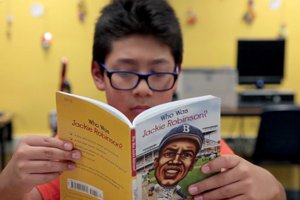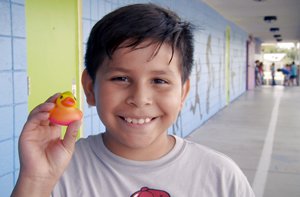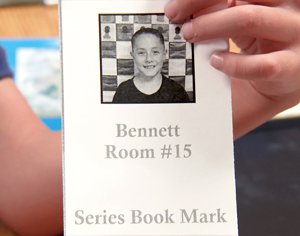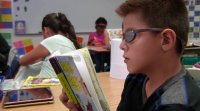A School-Wide Culture of Reading
Having kids in all grades read multivolume book series pays off in student fluency and engagement with reading.
Your content has been saved!
Go to My Saved Content.Overview
At Walter Bracken STEAM Academy Elementary, a Title 1 magnet school in urban Las Vegas, Nevada, educators have created a culture of reading by introducing Series Reading across all grade levels.
- By fifth grade, students are two and a half years above grade level on the STAR Reading Assessment.
- Instead of talking about the latest TV shows, students excitedly discuss the books they read.
- Students are often caught reading books under their desks during other lessons.
"Kids are hungry to read," explains Anna Hurst, Walter Bracken's assistant principal. "They come in on a Friday and ask me, 'Can I check out two books?' because they want to take two books home on the weekend."
The Series Reading program supplements curriculum. "That reading program gives me more hours than any other teacher," says Klaus Friedrich, a Walter Bracken fifth-grade teacher. "I feel like I'm at a higher-level middle- or high-school ability with them as far as understanding plot, character development, complexity, and style because I'm not spending a lot of time on fluency."
The Benefits of Reading a Book Series

Walter Bracken didn't always have a culture of reading. A lot of their kids weren’t finishing their books at home. They would read a chapter and stop, and they weren't doing their reading logs. To remedy this, teachers introduced Series Reading to their students.
When students read a series:
- They deepen their connection with the books’ characters.
- They increase comprehension.
- They increase reading time.
- They don't waste time trying to decide what book to read next.
For ELL students:
- They are familiar with the characters.
- They are familiar with the vocabulary that the author uses.
- That familiarity helps increase success and understanding with each book in the series.
"They read tons of series each year, and they just don't stop," says Katie Decker, Walter Bracken's principal. “We found this magical thing where they were talking about characters and comparing and contrasting in the hallway.”
How It's Done
Step 1: All Staff Choose Their Favorite Book Series
Every staff member at Walter Bracken -- from teachers to administrators to nurses -- chooses a series that will be in their office or classroom. Students have to visit these spaces again and again to check out books from their series. This allows each staff member to:
- Share their excitement for reading with students and discuss the books.
- Know what books students are reading and when they're checking them out.
- Take part in creating a culture of excitement around reading.
"I keep over 17 series in my office. My office is their office," says Decker, “and I want the children to know that I value literacy and those are my favorite book series, too.”
To get started, Decker recommends:
- Have staff members select a book series that they know and enjoy.
- Purchase books and store them in the classrooms and staff offices.
- Ask for used book donations.
- Create a Target gift book registry.
- Purchase more than one of each title so that multiple students can read the same series at once. Bracken purchases six of each title.
Step 2: Assess Your Students
Walter Bracken teachers initiate a benchmark test using the Accelerated Reader (AR) program, and they use AR quizzes to test students on their comprehension after they finish each book. This assessment helps teachers to know whether or not their students understand what they're reading.
With this benchmark, students get to read at their level, differentiating their learning, and they can choose which series within their level they want to read. Teachers use colors to represent each reading level. They put colored dots (pink, blue, orange, etc.) on the spines of each book so that students know whether the books are within their reading level. They also have a website listing each series by grade level and color code to help students decide which series to read next.
For teachers who want a low-cost alternative to AR, Decker recommends:
- It's free for up to 200 students.
- You can create paper or computer quizzes.
- You can assign a point system for each book completed.
- You can have unlimited users.
- Students can take quizzes online.
- You can assign a point system for each book completed.
Paper
- Create paper quizzes on each book.
- Place a basket in your classroom for students to drop off their completed quizzes.
Step 3: Acknowledge Your Students When They Finish a Series

Students at Walter Bracken are acknowledged and rewarded when they achieve their reading goals. Their progress is tracked through the Accelerated Reader program. AR assigns points to students based on how much they have read and the level of difficulty at which they're reading, and teachers use this data to gamify students’ reading.
For lower elementary, students are motivated to read at first because they're excited to get the rewards, like trophies or wearable trinkets. As they get older, it becomes less about the incentives. The rewards help build the habit of reading, but it's the reading itself that engages the students.
"The books entice the kids to read," explains Decker. “Once they get into the characters, they get excited about it. The conversations with the adults on campus, the conversations with their peers about the series -- that entices them to read.”
"Sometimes the books are so interesting that I actually feel that I'm in the book," says Braulio, a Walter Bracken fourth-grade student.
These are some of the school-wide rewards that students earn:
- A dog tag when they finish their first book series
- A charm to add to their charm necklace when they finish reading a series
- A Lucky Ducky (a cute and coveted plastic duck toy) when they earn 20 AR points within a month
- I spy tickets for reaching a reading goal -- ten I spy tickets are worth a treat from the principal's office on Fridays
- A trophy for one class in each grade with the most AR points by the end of the month, encouraging a sense of community among students
Walter Bracken purchases their rewards at fitnessfinder.net and orientaltrading.com. For a low-cost alternative, Decker suggests hanging a chart on your classroom wall to showcase which series your students have completed. The school also asks their graduating fifth-grade students to donate their charms back to the school. Most kids do, and those charms can be cleaned and reused.
Step 4: Help Your Students Navigate Which Book to Read Next
When Walter Bracken first created the Series Reading program, the younger students would spend ten minutes looking at all the covers trying to find the right book, because they didn't know which book in the series came next.
Teachers solved the problem by creating series bookmarks (PDF). Each book series has its own bookmark displaying the titles and covers of each book. This helps students easily identify the order of the books within a series, helps them keep track of which ones they've read, and is also a place to record their AR score for each book.
Step 5: Track the Books That Your Students Are Checking Out
When each student begins reading, they get a face bookmark. Completely unrelated to the popular social media site, these are bookmarks showing the student's face, his or her room number, and the teacher's name on the front. The back of the bookmark is full of blank lines for students to fill in which series they've completed.

At a glance, this helps teachers to identify how far their students are in their reading, and it also helps staff track which students have their books when they need to collect them at the end of the year. These face bookmarks serve as sign-out slips. When students check out a book, they leave their face bookmark with the staff.
Decker recommends other ways of tracking books:
- A sign-out sheet in a binder
- A chart on the wall
- The Book Retriever app on iPad ($.99)
"Stick to the series idea," advises Decker. "It's tricky at first, but it will pay off. Be flexible. You are changing bad habits for older kids. The younger grades are the easiest to start!"
